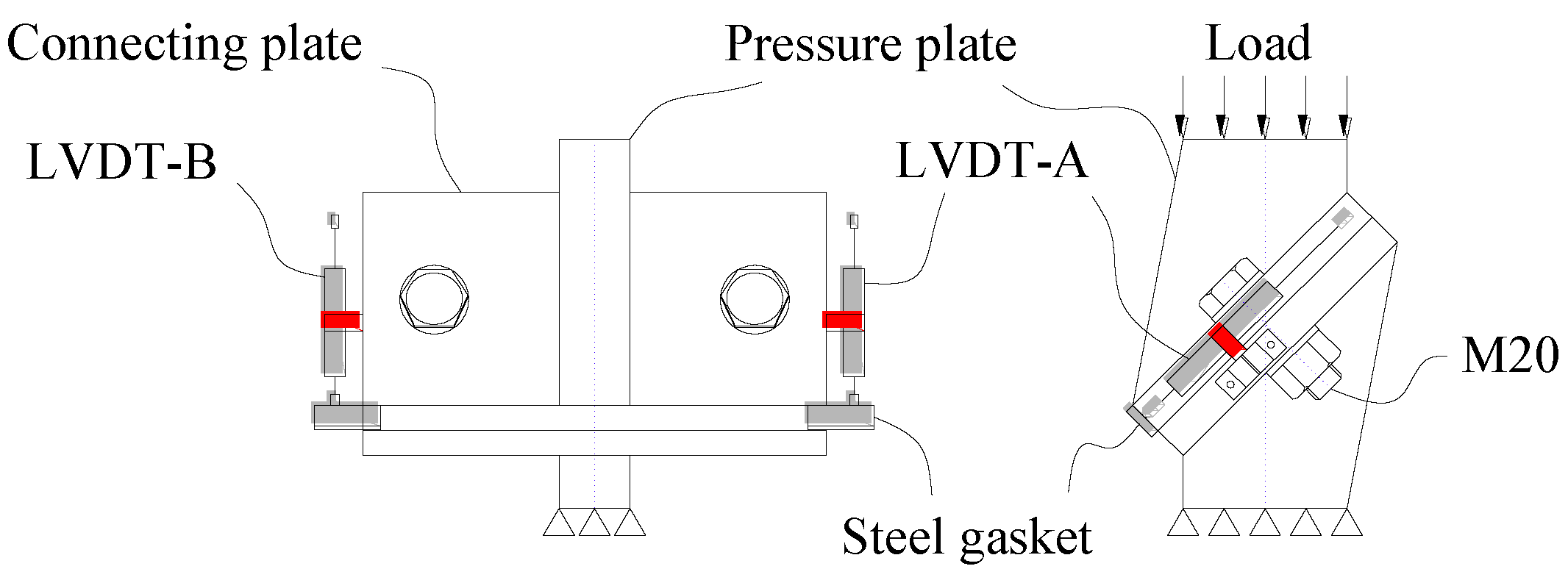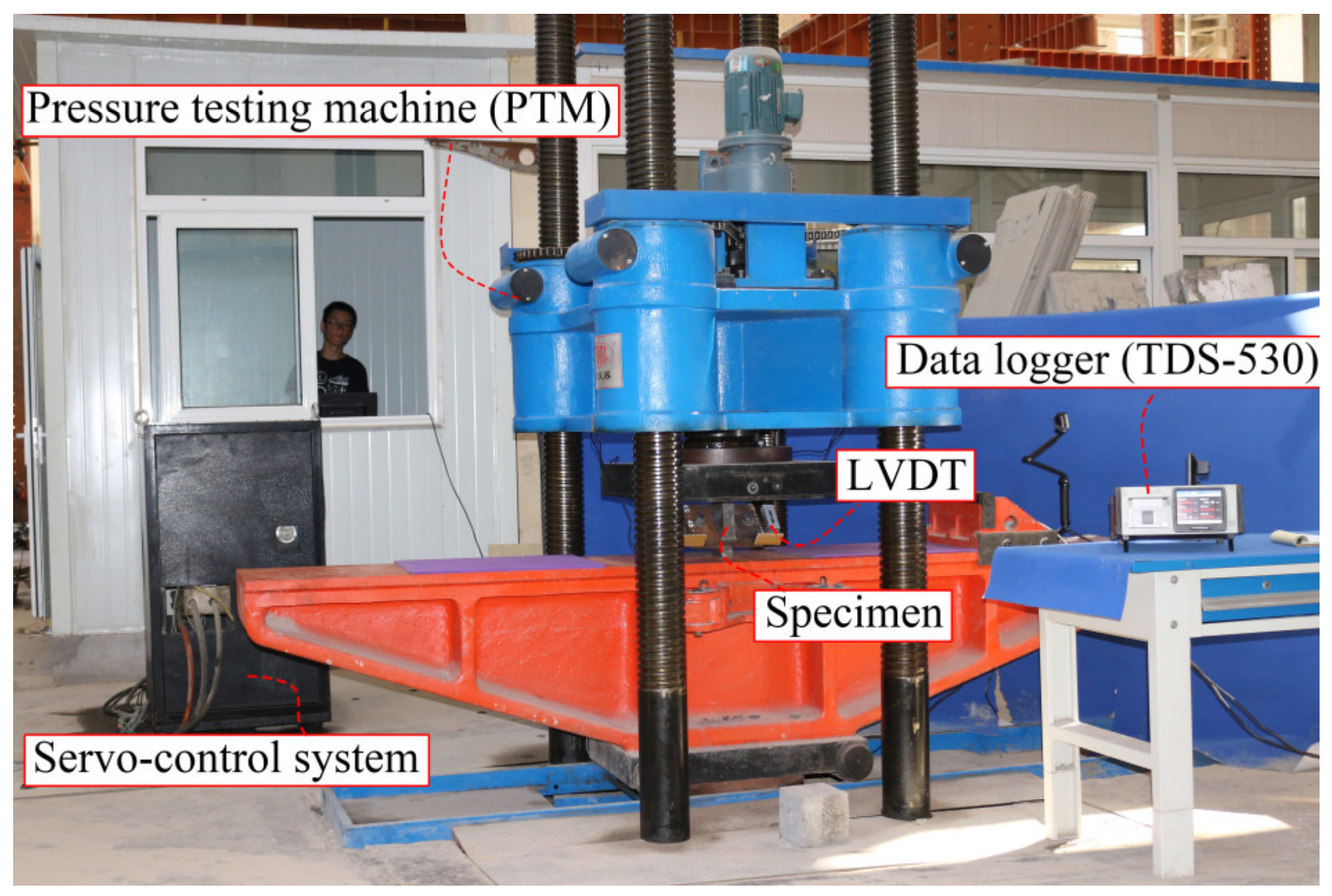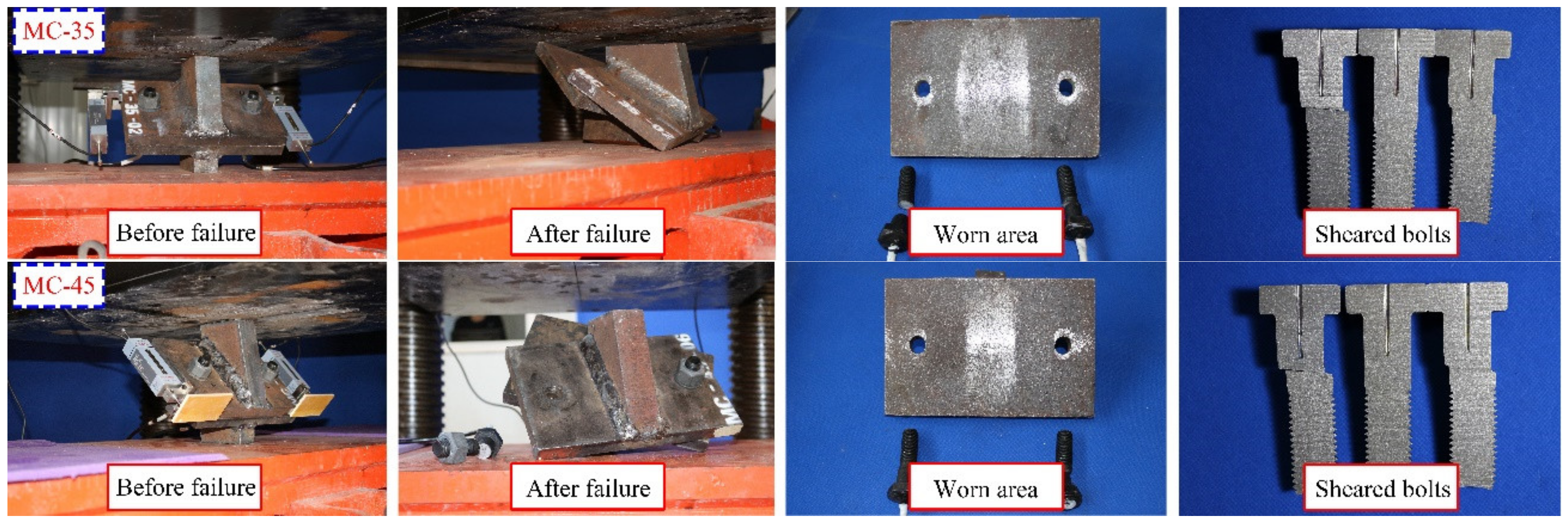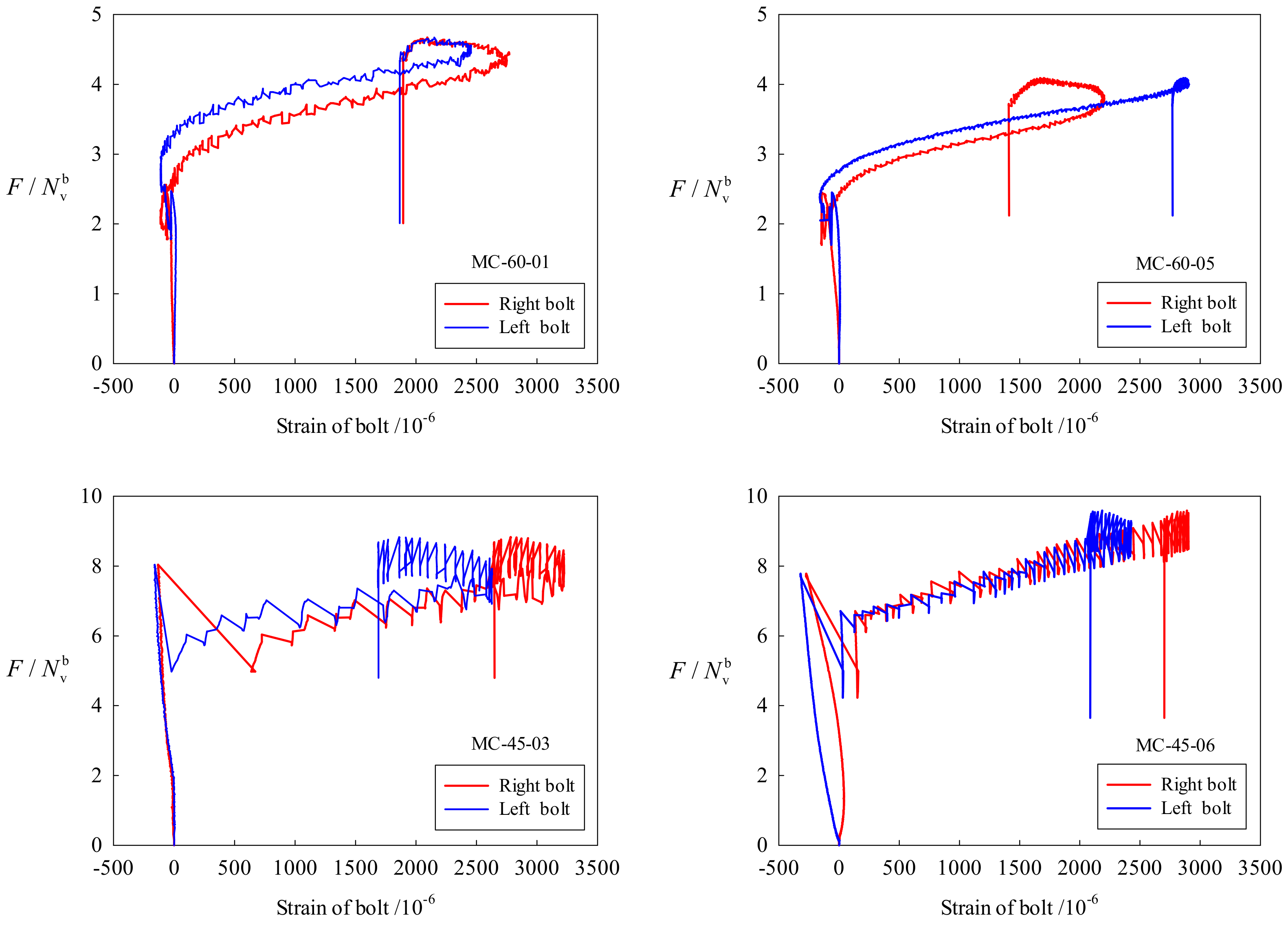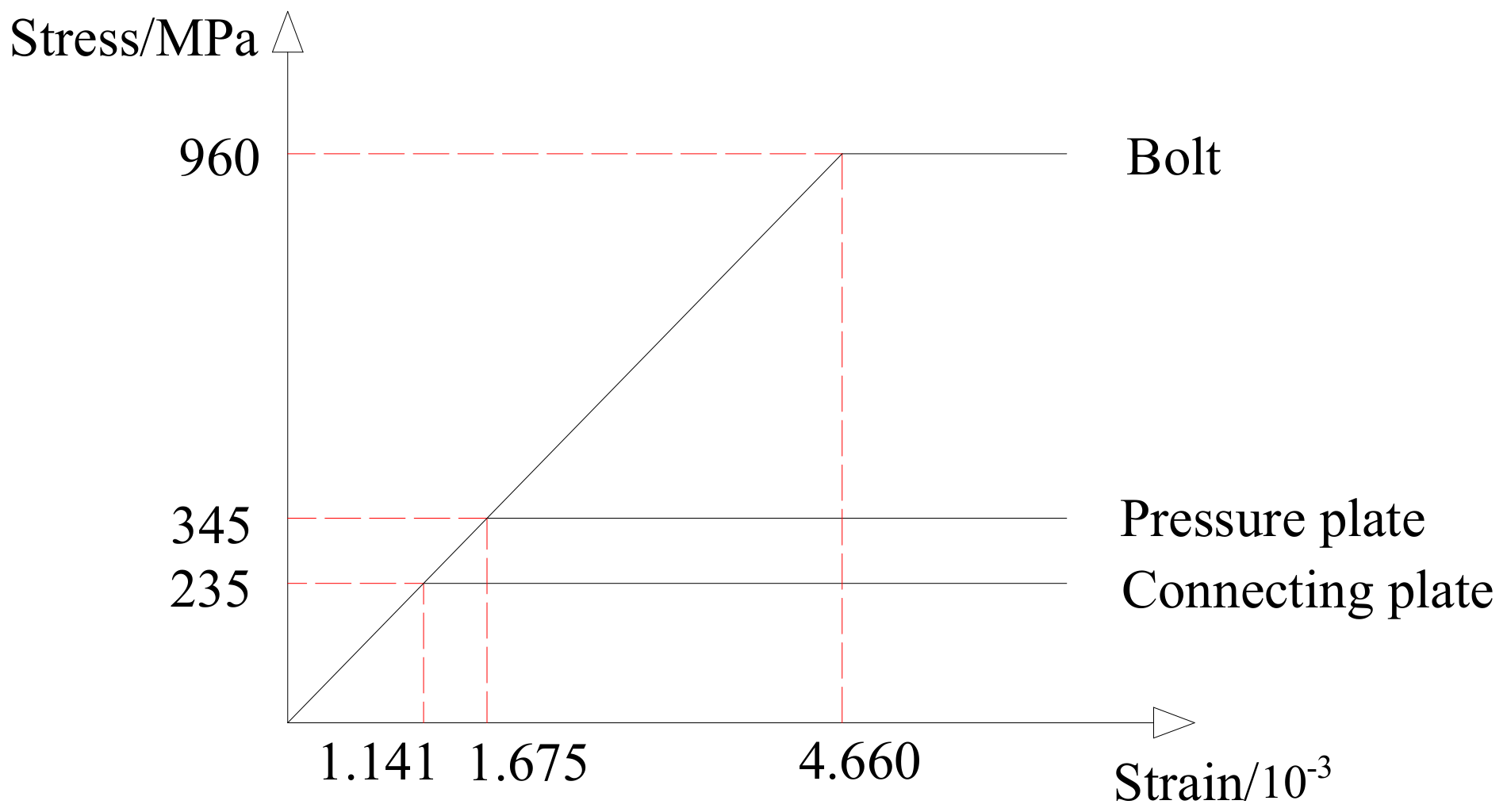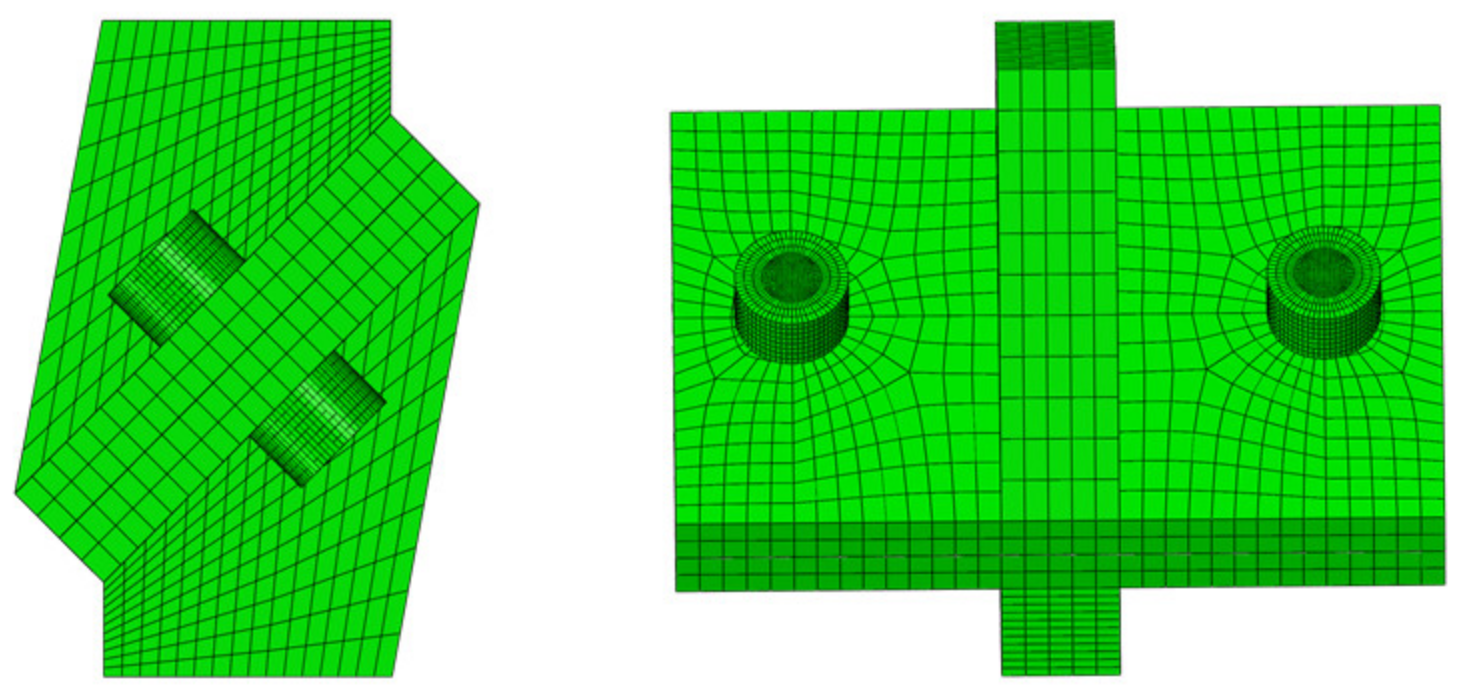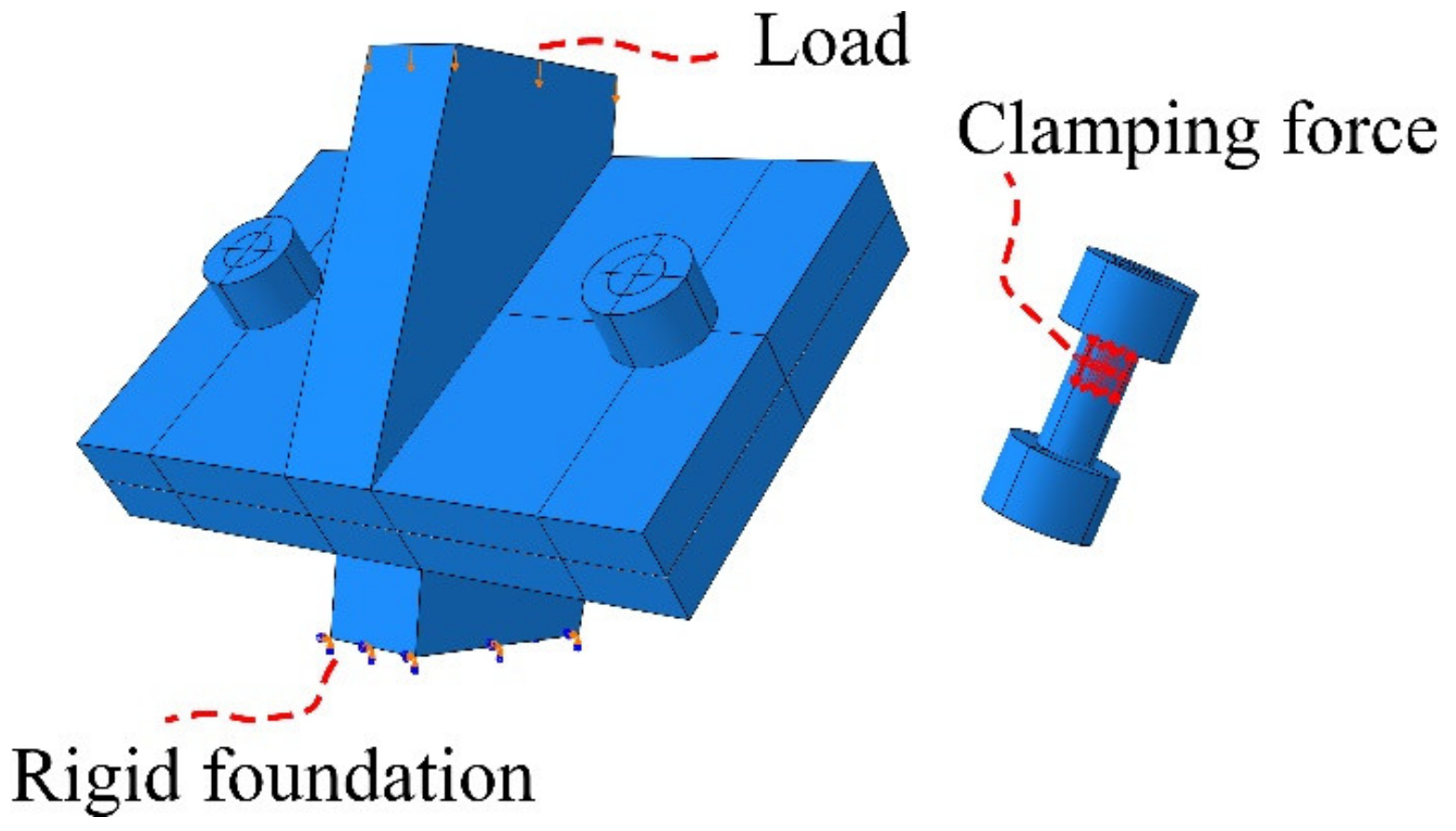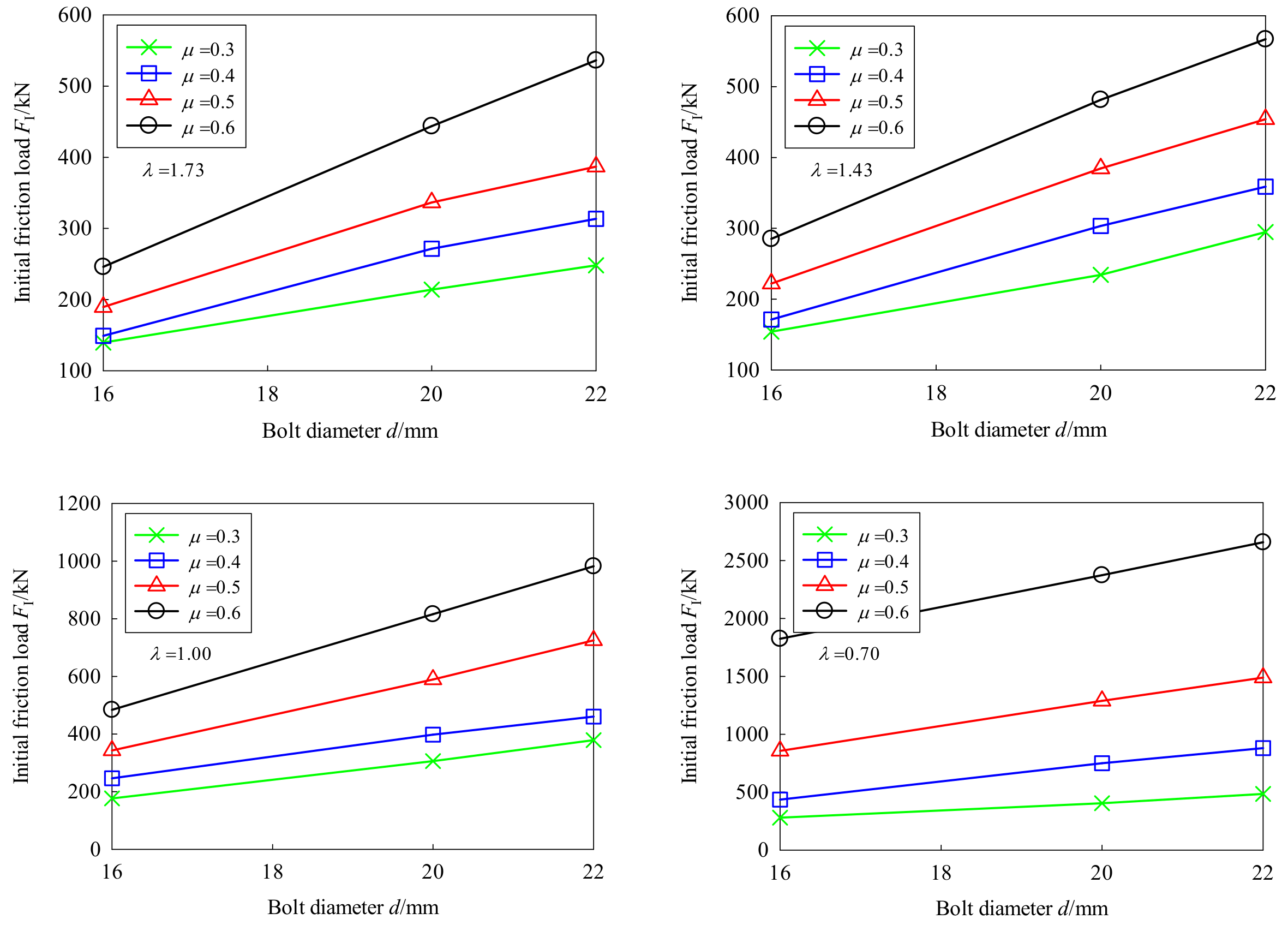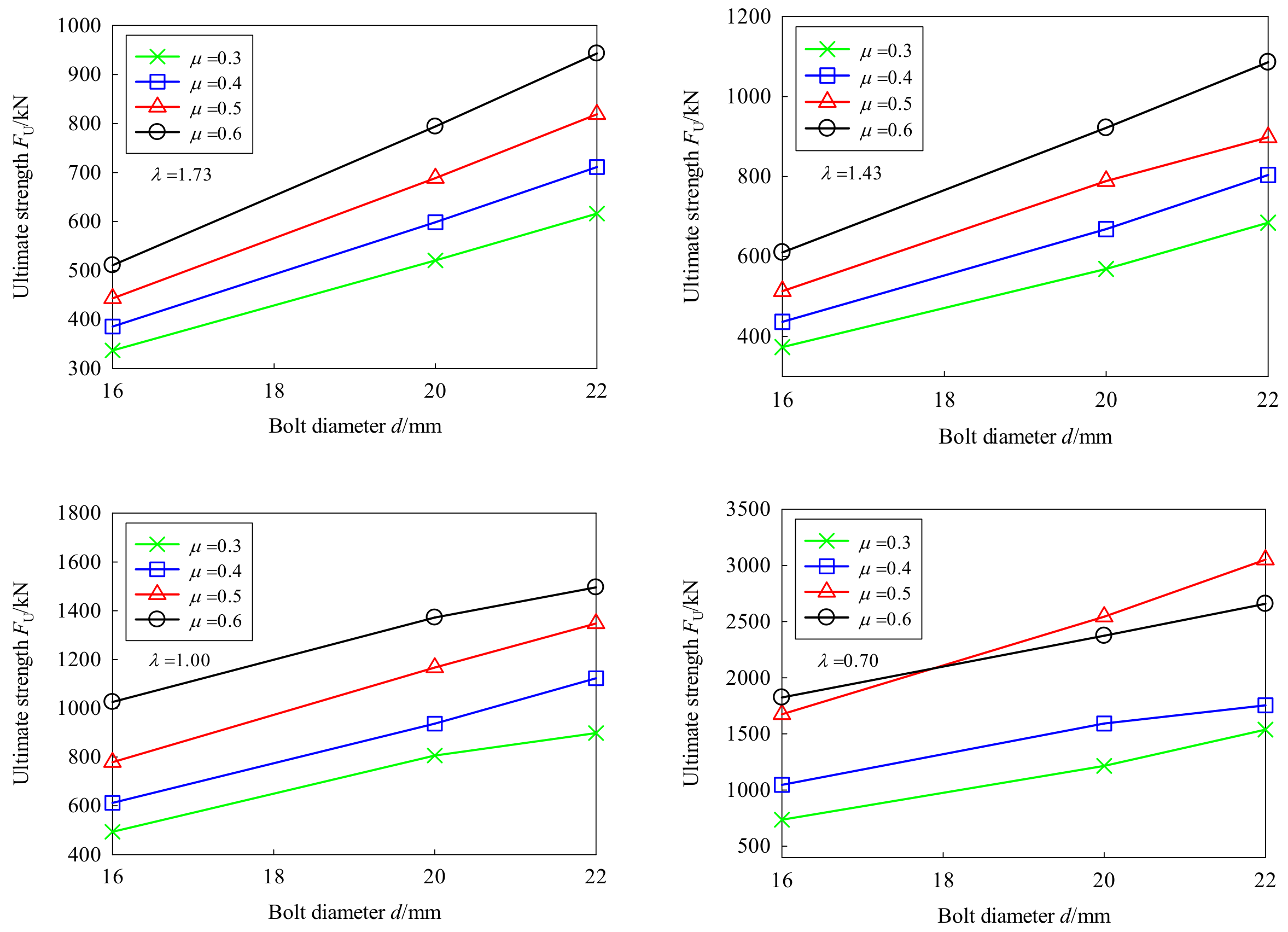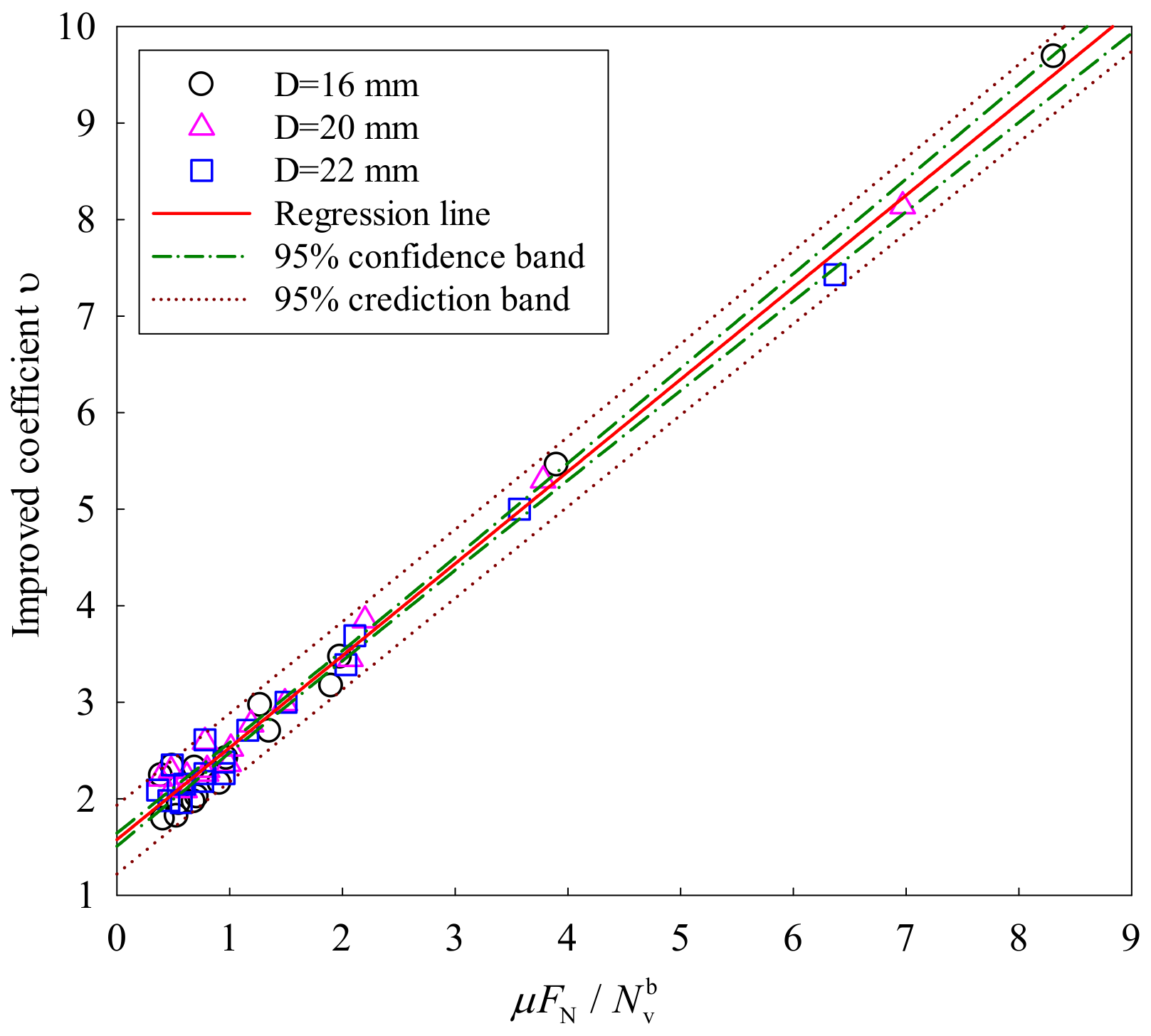1. Introduction
Box girder cracking and mid-span deflection are common problems of prestressed concrete (PSC) continuous box girder bridges (CBGBs) around the world [
1,
2,
3,
4,
5]. Traditionally, these problems have been effectively treated by pasting carbon fiber cloth, applying steel plate, increasing sectional size and adding prestressing tendons. However, the traditional methods vary greatly in enhancement effect, when the PSC-CBGB has a long span and serious problems [
6].
The cable-stayed system (CSS) is a novel active reinforcement method that improves the shear capacity and mid-span height of the girder [
7,
8]: on each side of the pile foundation, a steel joist is added in the tower laterally to the lower part of the girder, the steel joist is joined to the girder by a connection in the anchorage zone at the bottom of the girder and stay cables are anchored from the tower to the steel joist. In this way, cable forces are transmitted from the girder via the joist and the connection. The steel joist and the girder are generally connected tightly with both bolts and welds or with high-strength bolts [
9,
10,
11,
12,
13]. The bolted–welded connection faces two defects: on the one hand, the connection is difficult to construct or dismantle, and poor in reliability. Although a welded connection is stronger than bolted connections, the quality of it is unreliable, especially when it is not factory-made. Compared with a welded connection, a bolt connection has a quick construction speed and requires fewer skilled workers. From an economic and performance perspective, all of these give bolted connections a distinct advantage over a welded connection [
9]; on the other hand, each connection has a unique stiffness and ductility, and complex mechanical properties [
14]. The effects of these demands are often compounded by the sensitivity to fracture typical welded connection details. Even if the welds are properly executed, these strain demands will lead to tearing of the base metal in proximity of the weld access hole. This results in low rotational ductility and poor connection performance under large cyclic load reversals [
15]. These defects are made up of a high-strength bolted (HSB) connection, which has been widely applied in bridges and other steel structures [
16,
17]. Based on the load transfer mode, the HSB connections can be divided into the bearing type and the friction type. For the bearing type HSB (BHSB) connection, the shear force is transmitted by the wall pressure and the screw shear. Despite its high ultimate bearing capacity, the BHSB connection is not applicable under dynamic load or fatigue load. For the friction type HSB (FHSB) connection, the shear force is transmitted by the friction between the contact surfaces. Compared with a BHSB connection, high tensile strength in flexure and tensile behaviors, high performance in fatigue loading due to the reduced stress range, avoidance of bolt loosening to vibration, etc. [
18,
19]. The FHSB connection has been extensively adopted for the connections in bridges [
20,
21]. As shown in
Figure 1, FHSB connections have been employed for the CSS enhancement of Dongming Yellow River Highway Bridge.
In engineering practice, many bolts are implanted to provide the connection with required shear capacity according to the
Standard for Design of Steel Structures (GB 50017-2017) [
22]. However, the relevant design specification and research results do not involve the design method of the anti-slip bearing capacity for FHSB connections under combined shear and compression. The friction load of such a connection depends heavily on the pressure from the cable force and the friction between the contact surfaces induced by the axial force of the bolt. In our previous research, a scaled model test was carried out on the connections in the anchorage zone of the Dongming Yellow River Highway Bridge. The results show a positive correlation between cable force, the pressure on the contract surfaces and the loss of shear force and the clamping force of the bolt. This calls for further analysis on the friction load of FHSB connections [
23]. The rough contact surface of the sand blasting connection plate may be partially buckled after slippage, and the friction coefficient may change, making it difficult to evaluate the ultimate strength of FHSB connections. [
24,
25].
As shown above, no research has been reported on the static strength of the FHSB connections under combined shear and compression. To overcome the difficulty, this paper presents a novel FHSB T-stub connection, which is simple in structure, definite in load condition, and easy to construct. To identify the mechanical properties of the proposed connection, static load tests were carried out on 21 specimens under different shear–compression ratios, and the FE models were created for each specimen. The shear–compression ratio was adjusted by changing the size of the pressure plate. On this basis, the authors compared the specimens in failure mode, initial friction load and ultimate strength, summed up the relationship between shear capacity and shear–compression ratio, and verified the FE models. In addition, 144 FE models were adopted for parametric analysis. In this way, the shear capacity formula of FHSB T-stub connections was obtained under shear and compression. The research results provide a reference for the connection design of CSS-enhanced PSC-CBGBs and diagonal bracing.
2. Selection of Anchorage Angle
Before the static load tests, it is necessary to define the range of the anchorage angle
θ (i.e., the angle between the stay cable direction and the normal direction of the anchor point), which affects the magnitude of the normal component
FN and tangential component
Fv of the cable force
F at the connection in the anchorage zone at the bottom of the girder. The normal component is positively correlated with the pressure on the contact surfaces and the lifting force of the girder, while the tangential component is positively correlated with the shear on the contact surfaces and the shear resistance required for the connection. As shown in
Figure 2, the anchorage angle
θ depends on the tower height
H (i.e., the vertical distance from the anchor point of tower to the deck) and the distance
x between the anchor point and symmetrical center. For partially CSS-enhanced bridges, the ratio of tower height
H to the maximum span
L ranges from
L/12 to
L/4. The tower height
H should be maximized (
H =
L/4) to increase the cross-sectional height of box girder. The maximum value falls in the distribution range of anchor points (i.e.,
L/8-3
L/8 away from the center line of pier) specified in the
Guidelines for Design of Highway Cable-stayed Bridge (JTG/T D65-01-2007) [
26]. The statistics on 152 PSC-CBGBs (
L ≥100 mm) around the world show that the anchorage angles vary between 36.41 and 55.01°. Therefore, the anchorage angle of the specimens was set to the range of 35–60° in the tests, and the corresponding range of shear–compression ratio is 0.70–1.73.
6. Bearing Capacity of the FHSB T-Stub Connection
The initial friction load is the most important design parameter of the FHSB T-stub connection under the combined effects of shear and compression. Considering the effects of the bolt diameter, shear–compression ratio and friction coefficient on the initial friction load, this paper put forward the calculation formula of the initial friction load of the FHSB T-stub connection under both shear and compression through regression analysis. The shear capacity of the FHSB T-stub connection can be computed by the following regression equation:
where,
FN =
FIcos
θ is the normal components of the initial friction load on the contact surface of connecting plates.
Figure 25 shows the relationships between the initial friction load and different parameters of 48 finite-element models under the 95% confidence and prediction interval. The R-squared value of Formula (4) was computed as 0.9892. The results of ANOVA (analysis of variance) are shown in
Table 6.
It can be seen from
Table 6 that the significance test resulted in
p < 0.05, so the parameter selection had a significant influence to the initial slippage load. In addition, in this paper, the Shapiro–Wilk test was used to test the residual samples, and the calculated W = 0.954 and
p = 0.054 (significance level = 0.050), which followed the normal distribution. If the initial friction load
FI is infinite, the connection will self-lock. Accordingly, the friction coefficient was linearly correlated with the shear–compression ratio, and the ratio coefficient was 0.9538.
7. Conclusions
This paper designed a novel FHSB T-stud connection based on the structural features in the anchorage zone of a CSS-enhanced PSC-CBGB. Then, static load tests were conducted on 21 specimens with different shear–compression ratios, followed by finite-element modeling of the specimens. The specimens were investigated and compared in the failure mode, initial friction load and ultimate strength. After that, FEM based numerical simulation was performed to analyze the effects of multiple parameters on the initial friction load and the ultimate strength. The analysis results were used to evaluate the load-bearing capacity of the FHSB T-stub connection. The main conclusions are as follows:
- (1)
Under the combined effects of shear and compression, the FHSB T-stub connection mainly suffered from bolt shearing failure. The load–displacement curve generally covered four stages: the elastic stage, yield stage, hardening stage and failure stage. If the shear–compression ratio is small and the friction coefficient is large, the ultimate strength of FHSB T-stub connection equals its initial friction load. In this case, the load–displacement curve for the connection only contained the elastic stage and failure stage.
- (2)
The finite-element model proposed in this paper is suitable to study the mechanical behavior of FHSB T-stub connection under both shear and compression.
- (3)
The friction coefficient and shear–compression ratio had great impacts on the initial friction load, improved anti-slip coefficient and ultimate strength. The larger the friction coefficient, the smaller the shear–compression ratio, and the better the anti-slip bearing capacity of the FHSB T-stub connection.
- (4)
The initial friction load and ultimate strength increased linearly with the growing bolt diameter. For every 1 mm increase in bolt diameter, the initial friction load increased by about 10%, while the ultimate strength increased by about 8.5% within a 16–22 mm-diameter.
- (5)
The initial friction load increased linearly with the increase of clamping force, while the ultimate strength showed a linear decline. For each 10% increase/decrease of the design clamping force within 16–22 mm-diameter bolts, the initial friction load decreased/increased by 7.8%, while the ultimate load remained basically the same.
The proposed formula of shear capacity and self-lock angles of FHSB T-stub connection could be applied to the design of CSS-enhanced PSC-CBGBs and diagonal bracing. However, this paper only studied the friction coefficient, shear–compression ratio, bolt diameter and clamping force within a certain range, and the conclusions obtained had a certain scope of application. In addition, the influence of plate thickness and nut corrosion damage on the mechanical properties of the FHSB-T stub connections under shear and compression, and the variation law of friction coefficient after first slipping need to be further studied.



